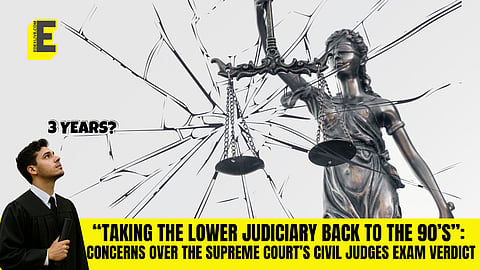

On May 20, 2025, the Supreme Court reinstated the requirement that candidates for the Civil Judge (Junior Division) examination have at least three years of legal practice.
A bench led by Chief Justice of India BR Gavai, including Justices AG Masih and KV Chandran, delivered the ruling.
History of the rule
The three-year practice rule was first introduced by the Supreme Court in 1993 in the All India Judges Association v Union of India case to ensure that those who preside over courts have firsthand experience of the legal system.
However, the rule was scrapped in 2002 after the Shetty Commission argued that the requirement held back young legal talent from joining the judiciary.
For over two decades, law graduates were allowed to compete for judicial posts immediately after graduation, provided they underwent a year of training if selected.
Why change now?
The Supreme Court's latest decision follows extensive feedback from high courts and state governments, most of whom expressed concerns about the preparedness of fresh graduates.
In its verdict, the court cited that recruiting "raw graduates" as Judicial Officers — without prior training or experience in lawyering — had not proven successful.
The bench noted that while theoretical knowledge is essential, real-world experience is invaluable in delivering justice.
New eligibility criterion
According to the recent verdict, entry-level judicial service post candidates such as Civil Judges, Junior Division, and so on, must have at least three years of practice as an advocate or a law clerk to a judge.
Certification of practice must be provided by a Principal Judicial Officer or an advocate with at least 10 years of experience endorsed by a judicial officer.
After completing three years of legal practice, the candidate becomes eligible to appear for the entry-level judicial service examination.
Once selected through this examination, the candidate must undergo one year of judicial training before presiding over court proceedings.
Implications: Concerning for most
Shahaj Arora, a teacher at TLOI Judiciary Academy, expressed deep concern about the future of the lower judiciary, describing it as the "first interaction point of the public with the legal system."
The Supreme Court's introduction of the three-year practice requirement has added significant complexity for law graduates aspiring to judicial service.
After completing a five-year or three-year LLB — typically finishing at age 23 or 25 — candidates must now practice for three years, which raises their age to around 26 or 28 before they even become eligible to apply.
Given that judicial service exam notifications are irregular and unpredictable, there is no assurance that vacancies will be announced as soon as candidates become eligible.
The exam is a long process with three stages: Prelims, Mains and Interview, which is carried out for almost 1.5 to 2 years.
Additionally, most candidates clear these exams on their second attempt, and even after selection, they must undergo an additional year of training before starting as judicial officers.
Balancing the demands of legal practice with the intensive preparation needed for these exams is highly challenging.
Arora also noted that the new requirement adds significant complexity for law graduates aspiring to do judicial service and may deter many talented students from economically disadvantaged backgrounds, potentially reducing diversity and inclusivity within the judiciary.
There are also concerns about the impact on female representation in the judiciary.
Many believe the three-year practice clause will further deter women from entering the field, exacerbating already low representation.
"Here's a reason why women's representation is so abysmal and whatever representation there is is limited to the lower ranks of judiciary. And by implementing the 3-year practice clause, they're creating a further deterrent for women to enter the field." commented an X user, aloo tikki hater @thisisnotnayan
What could have been done?
Arora considers this a regressive step, taking the lower judiciary back to the 90s.
"A better solution would have been implementing a one-year practice requirement, as Delhi suggested. ", he said
According to him, Students would have accepted that. They are not opposed to the idea of gaining practical experience. However, it would have been preferable if the court had presented empirical data to justify the introduction of this practice clause.
S Manaswini, an aspiring judiciary servant, remarks, “I do not want to skip the practice period. I think it will help me put the theory I learn through LLB into practice. I wish it were for a year or so, then we would have enough time to prepare, also.”
Arora also mentioned, "I have seen female students break down in tears because of this decision. It will leave students who have dedicated themselves wholeheartedly to their studies for the past two years feeling devastated."
He also suggested, "It would have been more sensible to involve deans of law colleges to understand students' perspectives better."
Many people believe that the actual impact of this decision will not be felt immediately but will become apparent over the next five to ten years, raising concerns about the future of the judiciary in India.
